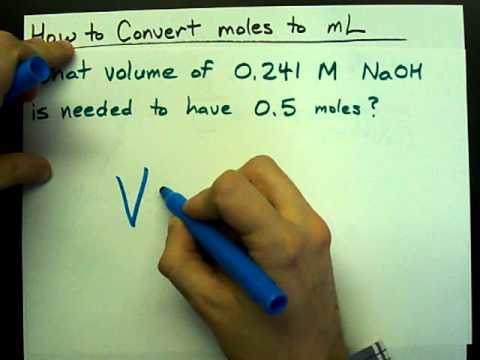In the world of chemistry, the mole is a fundamental unit used to measure the amount of a substance. It’s akin to counting eggs by the dozen, except in the molecular world, we count atoms and molecules by the mole. To calculate moles from milliliters, we need to bridge the gap between the volume of a liquid and the number of particles it contains. It may seem daunting, but it’s actually a straightforward process that involves understanding concentration and the molar mass of the substance in question. With a few simple equations and a clear approach, anyone can learn to perform this practical and essential calculation.

Understanding Concentration
Calculating moles from milliliters begins by understanding the concept of concentration, which tells us how much of a substance is present in a certain volume of solution.
- Begin by identifying the concentration of your solution, which is commonly given in molarity (M). Molarity is defined as moles of solute per liter of solution (mol/L).
- Use a measuring device to accurately measure the volume of the solution in milliliters (mL). Remember, there are 1000 milliliters in one liter.
- Convert the volume from milliliters to liters by dividing the milliliter value by 1000, as the concentration is given in moles per liter.
- Now, simply multiply the volume in liters by the molarity of the solution. This will give you the number of moles of solute present in your measured volume.
Summary: This approach is straightforward, allows for easy calculations, and is ideal for solutions where molarity is already known. However, it relies on accurate measurements and molarities; any errors here could lead to incorrect results.
Utilizing Molar Mass
To accurately calculate moles from milliliters when molarity isn’t provided, the molar mass of the solute is necessary. This is the mass in grams of one mole of any molecular substances.
- Note the substance’s molar mass, which is generally found on the periodic table or through a database for compounds. The molar mass is expressed in grams per mole (g/mol).
- Measure the mass of the solute you will dissolve in milliliters of solvent to make your solution.
- Divide the mass of the solute by its molar mass. This calculates the moles of the substance you have.
- Dissolve the calculated moles of the substance into the desired volume in milliliters.
Summary: Using molar mass is essential when the substance’s molarity is unknown. It provides an accurate means of calculating moles from a given mass. It requires careful measuring and attention to unit conversion yet is universally applicable to all substances.
Relating Density to Molarity
Sometimes, the solution’s concentration might be provided in terms of density, requiring additional steps to find the molarity.
- Find out the substance’s density, which should be given in grams per milliliter (g/mL).
- Measure the volume of the solution required.
- Multiply the density by the volume in milliliters to find the mass of the solution.
- Once you have the mass, use the molar mass of the solute to convert this mass into moles.
Summary: This method is handy when density information is available and can be especially useful for solutions that have a standardized concentration at a given temperature. However, it assumes a consistent density which might change with temperature fluctuations.
From Percentage Composition
Occasionally, a solution’s concentration might be presented as a percentage composition by mass, and this requires additional conversion.
- Recognize the percentage composition of the solution.
- Convert the milliliters of solution you have into grams using the density.
- Calculate the mass of the solute by applying the percentage composition to the total mass of the solution.
- Convert this mass to moles by dividing by the molar mass of the solute.
Summary: This method is very useful for commercial solutions with stated percentage compositions. Despite its accuracy, it does depend on the availability of density information and can become erroneous if the percentage composition is not precise.
Titration Data
Titration is a laboratory method used to determine the concentration of a solution, which you can use to find moles.
- Understand the concept of titration, which involves neutralizing a solution using a solution of known concentration.
- Acquire the titration data, which should provide you with the volume of the titrant used to reach the endpoint.
- Using the known concentration of the titrant, calculate the moles of the titrant used.
- Apply the stoichiometry of the reaction to find the moles of the solute in your original solution.
Summary: Titration is a precise and reliable technique for solutions suitable for this type of analysis. It requires an understanding of chemical reactions and stoichiometry, which may be challenging without a basic chemistry background.
Using Serial Dilution
In cases where the solution is too concentrated to work with directly, serial dilution can help determine the number of moles.
- Grasp the concept of serial dilution, which involves diluting a concentrated solution step by step until a measurable concentration is reached.
- Perform the serial dilution properly, being aware of the dilution factors at each step.
- Once a measurable concentration is achieved, you can use the molarity to calculate the moles in the diluted solution.
- Use the dilution factor to backtrack and determine the moles present in the original, concentrated solution.
Summary: This method is valuable for handling highly concentrated solutions but requires precise dilution and calculation to account for each step’s dilution factor.
Using Mole Ratios and Stoichiometry
When dealing with reactions, mole ratios from balanced chemical equations can help to establish the number of moles in a solution.
- Write down the balanced chemical equation for the reaction involving the solution.
- Identify the mole ratio between the reactants and products.
- Measure the volume and calculate the moles of another reactant or product, if known.
- Use the mole ratio to determine the moles of the substance in question within your measured volume.
Summary: This method is especially useful in a lab setting where reactions are involved. Its success hinges on a proper understanding of chemical equations and stoichiometry.
Employing the Ideal Gas Law
When working with solutions of gases in liquids, the ideal gas law can be utilized to calculate moles.
- Learn the ideal gas law, PV=nRT, where P is pressure, V is volume, n is moles, R is the gas constant, and T is the temperature in Kelvin.
- Rearrange the formula to solve for n (moles) if the pressure, volume, and temperature of the gas are known.
- Apply the calculated moles to the volume of liquid to determine the molarity.
Summary: This is most applicable to scenarios involving gases dissolved in liquids. It requires an understanding of gas behavior and accurate measurements of pressure and temperature.
Online Calculators and Tools
For those who prefer a straightforward approach without the math, online calculators can provide a quick solution.
- Locate a reputable online calculator designed for chemical calculations.
- Input the known values such as density, molarity, volume, or molar mass.
- Follow the prompts to receive the calculated number of moles.
Summary: Online calculators are convenient and user-friendly but rely heavily on the accuracy of input data and the correctness of the calculator algorithm.
Understanding Limitations and Precision
Calculating moles from milliliters can be affected by several factors that influence the precision of the measurement.
- Acknowledge the potential for error in measurements, both in volume and concentration.
- Consider the accuracy of the measuring instruments used.
- Recognize that approximations in molar mass and variations in temperature and pressure can impact the results.
Summary: Awareness of limitations and precision is crucial for interpreting results, especially when absolute precision is necessary for the experiment or process.
In conclusion, calculating moles from milliliters is a versatile skill that combines a bit of math with a solid comprehension of chemical concepts. Whether you’re a student facing a lab assignment or a hobbyist conducting experiments at home, understanding these various methods empowers you to tackle these calculations with confidence. Each approach comes with its own set of benefits and possible drawbacks, but knowing how to navigate them ensures that you’re well-equipped for any situation where this conversion is required.
FAQs
Q1: Why do I need to convert milliliters to liters when calculating moles?
A1: You need to convert milliliters to liters because the standard unit for molarity (concentration) is moles per liter. To maintain consistency and to use the molarity directly, the volume should be in liters.
Q2: Can I calculate moles from milliliters for any substance?
A2: Yes, you can calculate moles from milliliters for any substance, provided you know the required properties, such as molarity or molar mass, and properly account for the state of the substance (solid, liquid, gas).
Q3: What if my solution’s concentration is not given in molarity or weight percent?
A3: If your solution’s concentration comes in a different form, you may have to use additional information or convert it to molarity or weight percent to perform the calculation. Understanding the relationship between different concentration units is essential in such cases.









